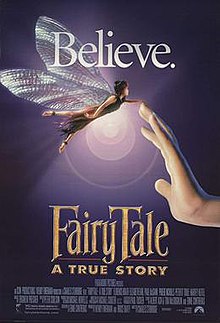FairyTale: A True Story
| FairyTale: A True Story | |
|---|---|

Theatrical release poster.
|
|
| Directed by | Charles Sturridge |
| Produced by |
Bruce Davey Wendy Finerman |
| Screenplay by | Ernie Contreras |
| Story by | Albert Ash Tom McLoughlin Ernie Contreras |
| Starring |
|
| Music by | Zbigniew Preisner |
| Cinematography | Michael Coulter |
| Edited by | Peter Coulson |
|
Production
company |
|
| Distributed by | Paramount Pictures |
|
Release date
|
|
|
Running time
|
99 min. |
| Country | United Kingdom |
| Language | English |
| Box office | $14,059,077 |
FairyTale: A True Story is a 1997 film from Icon Productions, loosely based on the story of the Cottingley Fairies.
Early 20th Century Europe was a time and place rife with conflicting forces, from the battlefields of World War I to the peaceful countryside of rural England. Scientific advances such as electric light and photography appeared magical to some; spiritualism was championed by Sir Arthur Conan Doyle while his friend Harry Houdini decried false mediums who prey upon grieving families. J.M. Barrie's Peter Pan charmed theatergoers of all ages. Young Frances Griffiths, whose father is missing in action, arrives by train to stay with her cousin Elsie Wright in rural Yorkshire.
Polly Wright, Elsie's mother, is deep in mourning for her son Joseph, a gifted artist who died at the age of ten, and she keeps Joseph's room and art works intact. Elsie is not allowed to wear colours or to play with his toys, but she has taken the unfinished fairy-house he built up to her garret bedroom where her doting father, Arthur, regales her with fairy tales. He is a bit of a local wunderkind, responsible for the electrification of the local mill, where children as young as Elsie go to work. He is also an amateur photographer and chess player. When Frances arrives she and Elsie discover a shared fascination with fairies, whom they encounter down at the "beck", a nearby brook. They abscond with Arthur's camera one afternoon to take pictures of the fairies, hoping to give Polly something to believe in. When she comes home after attending a meeting of the Theosophical Society, where she hears stories of angels and all sorts of ethereal beings, she finds Arthur reviewing the prints in disbelief, but she thinks they are real. She takes them to Theosophist lecturer E.L. Gardner, who has them analysed by a professional and then brings them to the attention of Sir Arthur Conan Doyle. The photos are pronounced genuine, or at least devoid of trickery.
...
Wikipedia
